How can I repair corrupted JPEG files? And Google’s useless results.
I have stated this before and I’ll do it again: Google Search sucks. To illustrate my point I’d like to show result for the query: “How can I repair corrupted JPEG files?” Google returns useless results at the top and even endorses them in featured snippets etc.. But the same is true for searches like “how to recover data from a formatted drive” or “how to recover a corrupt SD card”, you’ll get similar bullshit as top results.

Google JPEG repair top result.
The blog article is just a honey pot for the crappiest JPEG repair software on the planet today. It’s not just Nucleus, companies that unleashed DiskDrill, Easeus Data Recovery Wizard, RecoverIt etc. onto the world use the same scam tactics with honey pot articles that offer no real “solutions”. It is not uncommon if you fall into their trap and actually buy the ‘product’ they’re trying sell that you are actually buying a SUBSCRIPTION that automatically renews!!

Some times even MONTHLY!!

The Honey Pot
Let’s look at their suggestions, let’s descend into the rabbit hole ..
1. Change the Image Format
By changing the file format of JPEG/JPG files to another format might just do the trick. One can try importing the corrupt image to the Paint tool, which comes preinstalled with Windows. Then go to File > Save As and then select the format of your choice. Tinkering with different formats might undo the effect of corruption from images.
No. With any serious damage or corruption, changing the image format will not help. The issue is the software can not decode the JPEG. If it can not decode it, it can not save it (encode it) to a different format either.
2. Repair with Image Editors
Professional image editing tools such as Photoshop, Lightroom, and Picasa can also be used to repair benign JPEG corruption issues. It is often the case that merely opening these corrupt JPEG files with these tools and renaming them fixes the problem.
The reason you’re probably looking for JPEG repair software is the mentioned software actually not being able to open the file. In some cases tool X may support an obscure JPEG marker that tool Y does not. Only in those cases re-saving the file using tool X may make the file usable in tool Y. But in general, image editing tools are not JPEG repair tools.
3. Run the CHKDSK Scan to Repair the Bad Sector in the Hard Drive
The CHKDSK scan fixes the bad sectors on the storage drives. Use the following steps;
Go to Run and open the Command Prompt.
Type CHKDSK (drive-name) /r.
After the completion of the scan, restart your computer and check for the JPEG files.
In case a file ‘occupies’ a bad sector it will give you a read error related error message then you try to open the file. Your image editor will not open a corrupt JPEG, it will not open it at all. This is how read errors are handled within Windows.
Recovered JPEG files that are damaged due to bad sectors will open in an image editor and show some kind of corruption. However this damage is not fixed by chkdsk, as far as chkdsk is concerned this file is okay.
With ANY type of corruption, chkdsk is the tool you want to avoid! Chkdsk does not repair individual files, it repairs the file system.
4. Restore the JPEG File from the Backup
If you have taken the backup of your Windows files and it includes the particular JPEG file, then you can use the restoration process to retrieve the corrupt image file.
Yeah, DOH! If you have a backup you won’t be looking for an answer to this question in the first place, Einsteins!
5. Repair with a HEX Editor
A hex editor is a tool that is used to display raw data of the image file. One can edit the image with a hex editor to get rid of corruption. If some of the data is missing (showing zero bytes), then there can be difficulty in repairing the file. Some of the most common hex editor tools are HxD, Hex Workshop, Cygnus, and Neo.
This answer is so annoyingly stupid. Yes, you can repair a corrupt JPEG using a hex editor, IF you know what you’re doing. And people actually capable of this will not be helped by this answer one iota, and neither are the people who had no idea.
6. Use the Online Image Editors
There are different online image editors like Adobe Photoshop, Picasa, and Lightroom that can be used to create and modify image files. If your image is not opening, then you can try to access the image in such editors and fix the issues.
Same issues and answer apply as described in point 2. It does not matter if you use a local or online photo editor, problems and issues with corrupt JPEG files remain the same.
7. Use a Professional Tool
When these manual methods do not work for the repair of the image file, then the professional JPEG Repair software may be a savior for you. Kernel Photo Repair software is an efficient alternative for manual methods.
Kernel Photo Repair software is not a professional tool. Just watch the video I made and decide for yourself.
Ergo: Google Search is useless.
Google’s search algorithm can not tell useful content from utter bullshit. Due to the fact the Nucleus honey pot contains the search phrase it scores. The blog is long enough to keep you reading for a while. Maybe even you download the Kernel software. Apparently this is good enough for the Google algorithm to reach the conclusion the blog is high quality and to improve the ranking.
Of course I have to be honest and tell you I have no idea why this article ‘scores’ in Google Search results. All I know is, the search results are wrong. The article is not high quality and is mostly nonsense.